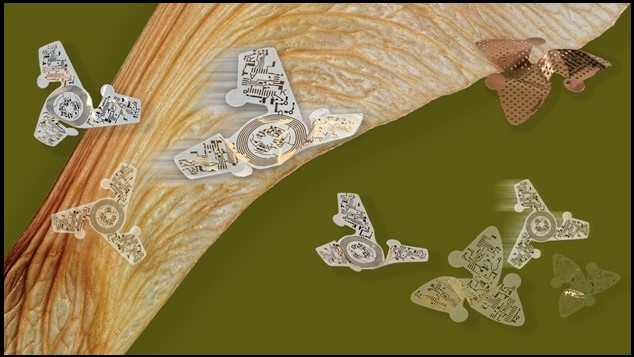A chip the size of a grain of sand packed with ultra-miniaturised technology, including sensors, power source and antennas, which could revolutionise wireless communication and monitoring has been developed by engineers at Northwestern University in the US.
The winged microchip, also called a microflyer, is actually the smallest-ever human-made flying structure.
It could be used for surveillance and to monitor air pollution, airborne disease and environmental contamination, and it even solves its own e-waste problem.
While it does not have a motor or engine, it catches flight on the wind and spins like a helicopter through the air toward the ground.
Think: Toy Story’s Buzz Lightyear who specialised in “falling with style” rather than flying.
“Our goal was to add winged flight to small-scale electronic systems, with the idea that these capabilities would allow us to distribute highly functional, miniaturised electronic devices to sense the environment for contamination monitoring, population surveillance or disease tracking,” said John A. Rogers, professor of materials science and engineering at Northwestern, who led the device’s development.
Beating nature at its own game
Although the device’s trajectory could be likened to Buzz, the researchers were actually inspired by the biological world.
In particular, the team studied the aerodynamics of plant seeds, drawing inspiration from the tristellateia plant, a flowering vine with star-shaped seeds.
Tristellateia seeds have bladed wings that catch the wind to fall with a slow, rotating spin.
“Over the course of billions of years, nature has designed seeds with very sophisticated aerodynamics.
We borrowed those design concepts, adapted them and applied them to electronic circuit platforms,” Rogers explained.
Computational modelling was used to identify the ideal structure for the flying device using advanced methods for imaging and quantifying patterns of flow with engineers at the University of Illinois.
Through this process, they’ve been able to create a variety of sizes and shapes, with varying properties.
Rogers likened it to beating nature in that they have been able to build structures that fall with more stable trajectories and at slower terminal velocities than equivalent seeds from plants or trees.
“We also were able to build these helicopter flying structures at sizes much smaller than those found in nature,” he said.
The microflyers comprise two parts: millimetre-sized electronic functional components and their wings.
The miniaturisation is important because devices, such as sensors, radios, batteries and other components, are being created in ever smaller dimensions.
As the microflyer falls through the air, its wings interact with the air to create a slow, stable rotational motion.
The weight of the electronics is distributed low in the centre to prevent it from losing control and chaotically tumbling to the ground.
Rogers and the team included sensors, a power source that can harvest ambient energy, memory storage and an antenna that can wirelessly transfer data to a smart phone, tablet or computer. “We envision a large multiplicity of miniaturised sensors that can be distributed at a high spatial density over large areas, to form a wireless network,” he said.
Dissolving e-waste
The prospect of creating a new wave of tiny e-waste has motivated the team to develop a solution within the device itself.
Electronics that can harmlessly dissolve in water after they are no longer needed, such as bioresorbable pacemakers, have been in development.
Roger said they are already fabricating physically transient electronics systems using degradable polymers, compostable conductors and dissolvable integrated circuit chips that naturally vanish into environmentally benign end products when exposed to water.
Using the same materials and techniques, the microflyers will naturally degrade and disappear in ground water over time.
“We recognise that recovery of large collections of microflyers might be difficult. To address this concern, these environmentally resorbable versions dissolve naturally and harmlessly.”










